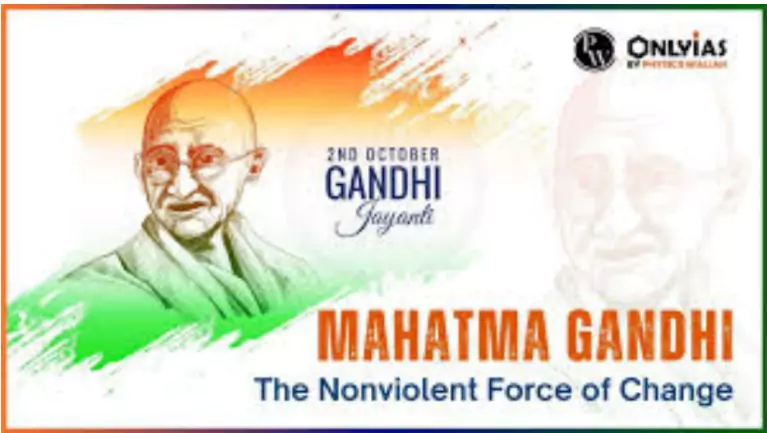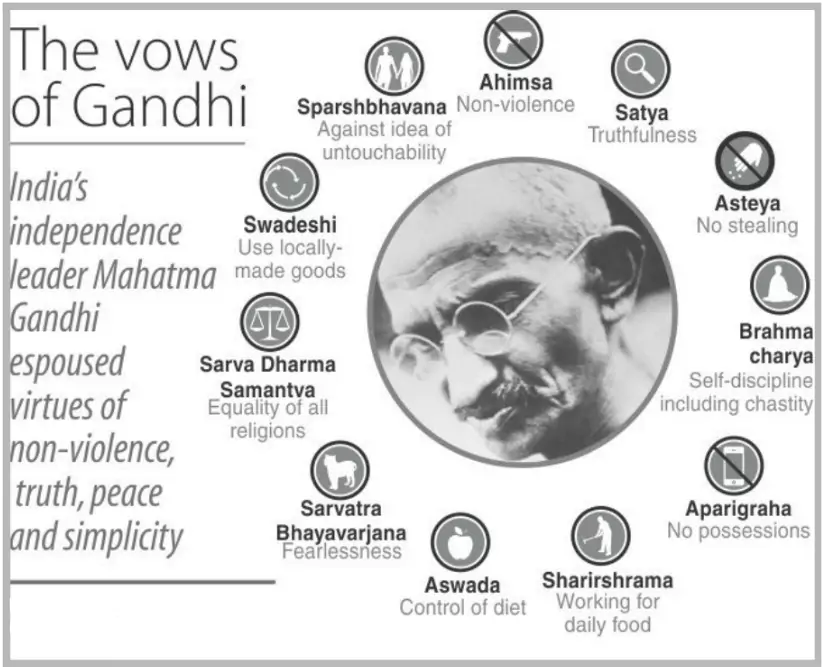Gandhi Jayanti, celebrated on October 2, marks the birth anniversary of Mohandas Karamchand Gandhi (Mahatma Gandhi).

- In 2025, India observes his 156th birth anniversary.
- Gandhi Jayanti is a national holiday in India and is also recognized worldwide as the International Day of Non-Violence.
- The day commemorates Gandhi’s principles of truth (Satya) and non-violence (Ahimsa), highlighting his enduring influence on India and the world.
About Mahatma Gandhi
- Birth and Early Life: Born on 2 October 1869 in Porbandar, Gujarat, Mahatma Gandhi was a lawyer, social reformer, and political leader who played a central role in India’s struggle for independence from British rule.
- Father of the Nation and Satyagraha: Known as the Father of the Nation, Gandhi pioneered Satyagraha, a method of non-violent resistance, which became a powerful tool against colonial oppression.
- Philosophy and Beliefs: Gandhi’s philosophy emphasized truth, non-violence, swaraj (self-rule), rural development, social equality, and simplicity in life.
 Leadership in Movements: He led movements such as the Champaran and Kheda agitations, Non-Cooperation Movement, Salt March, and Quit India Movement, while also advocating for the upliftment of marginalized communities, communal harmony, and economic self-reliance.
Leadership in Movements: He led movements such as the Champaran and Kheda agitations, Non-Cooperation Movement, Salt March, and Quit India Movement, while also advocating for the upliftment of marginalized communities, communal harmony, and economic self-reliance. - Legacy and Global Influence: His principles continue to inspire global peace and justice movements, reinforcing the contemporary relevance of his teachings.
Historical Context & Emergence of Gandhi’s Philosophy
- South African Experience (1893–1915): Gandhi’s confrontation with racial discrimination in South Africa was pivotal.
- Beyond facing injustice, he developed a political strategy and mass mobilization technique, which later became the foundation for Satyagraha.
- From Idealist to Practitioner: Gandhi’s experiences shaped his pragmatic approach—combining ethics, non-violence, and political action.
- His early work taught him that social and political change required discipline, leadership, and mass engagement.
- Impact on Indian Society: Gandhi’s movements politicized ordinary citizens—including women, peasants, and lower castes—for the first time, fostering participation, agency, and social awareness.
- Movements such as Non-Cooperation, Civil Disobedience, and Quit India shaped the social and political consciousness of India.
- Influences on Gandhi’s Ideology: Gandhi’s ideas were shaped by thinkers such as Leo Tolstoy, John Ruskin, and Indian leaders like Gopal Krishna Gokhale.
PWOnlyIAS Extra Edge:
Relevance of Mahatma Gandhi’s Philosophy in the 21st-Century Digital World
- In today’s digital age, historical figures are often reduced to memes, infographics, and soundbites. Gandhi resists such simplification; his ideas of peace, truth, and non-violence remain complex and deeply relevant.
- Paradox of Legacy:
- Immortalized in monuments and currency, yet often trivialized online.
- The algorithm-driven world prioritizes outrage and engagement, opposing Gandhi’s reflective and patient approach.
- Understanding Gandhi Beyond the Surface:
- Swaraj as Self-Mastery: True self-rule involved control over one’s impulses and ethical conduct, not just political independence.
- Post-Revolution Ethics: Focused on inclusive society and human dignity, beyond just replacing rulers.
- Digital World vs Gandhian Values:
- Algorithm vs Ahimsa: Online polarization contrasts Gandhi’s active non-violence and moral pause.
- Truth in the Post-Truth Era: Gandhi’s pursuit of Satya (Truth) as an objective clashes with subjective “my truth” narratives.
- Human Vulnerability: Gandhi’s self-correction and humility would be seen as weakness today, but were central to ethical leadership.
- Core Lessons for Today:
- Gandhi’s philosophy provides a framework for inclusive politics, ethical governance, and peaceful conflict resolution.
- Fully engaging with his ideas is an act of quiet resistance against simplistic digital binaries.
Conclusion
Even in the fast-paced digital world, Gandhi’s emphasis on reflection, moral courage, truth, and inclusivity continues to guide ethical action and social cohesion. |
His Core Philosophies
- Political Philosophy:
- Swaraj: Gandhi’s vision of Swaraj went beyond political independence, emphasizing self-rule at the individual, family, and village level.
- His model contrasts with Western liberal-democratic systems, highlighting moral responsibility and community participation.
- Satyagraha: Non-violent resistance, or Satyagraha, combined truth, courage, and civil disobedience.
- Gandhi advocated that ends do not justify means, focusing on moral high ground and ethical protest.
- Economic Philosophy:
- Swadeshi and Trusteeship: Gandhi promoted local production and consumption (Swadeshi) and the concept of Trusteeship, wherein wealth holders act as caretakers of resources for society.
- This philosophy prefigures modern Corporate Social Responsibility (CSR).
- Village-Centric Model vs Industrialization: Gandhi’s vision of Gram Swaraj emphasized self-sufficient villages, contrasting with Nehru’s industrialization approach.
- His economic thought prioritizes sustainability, local employment, and equitable resource distribution.
- Social Reform:
- Eradication of Untouchability: Gandhi’s Harijan campaign aimed to integrate the oppressed castes into mainstream society.
- He differed from B.R. Ambedkar, rejecting separate electorates, believing in social unity over political segregation.
His Moral and Physical Courage
- Johannesburg Plague (1904): Gandhi volunteered to treat abandoned plague patients, risking his own life, showing courage grounded in discipline and ethical responsibility.
- Priority to Principles: Gandhi continued to follow his commitment to nature cure methods even during Kasturba’s illness, prioritizing principles over expediency.
- Commitment to Non-Violence: The Chauri Chaura incident (Feb 5, 1922) resulted in 22 policemen dying, after which Gandhi called off the movement despite its popularity.
- Social Reform at Ashram: Gandhi admitted an “untouchable” family into the Ahmedabad Ashram, despite risking financial support, exemplifying moral courage in challenging societal norms.
- Discipline: Gandhi strictly enforced Ashram rules, even applying discipline to his own family members, emphasizing principles over personal affection.
- Noakhali Mission (1946): He walked barefoot through riot-affected villages, with no protection, fostering peace, reconciliation, and communal harmony.
- Facing Assassination Threats: Gandhi survived multiple attempts on his life yet refused police protection, demonstrating fearless commitment to his principles.
| Timeline of Key Events |
| Year |
Event |
| 1869 |
Born on 2 October, Porbandar, Gujarat |
| 1883 |
Married to Kasturba |
| 1888 |
Left for London to study law |
| 1891 |
Completed law studies; returned to India |
| 1893 |
Went to South Africa |
| 1894 |
Founded Natal Indian Congress |
| 1906 |
First Satyagraha campaign in South Africa |
| 1915 |
Returned to India |
| 1917 |
Led Champaran agitation |
| 1919 |
Protests against Rowlatt Act |
| 1920–1922 |
Non-Cooperation Movement |
| 1930 |
Salt March; Civil Disobedience Movement |
| 1942 |
Quit India Movement |
| 1947 |
India’s independence |
| 1948 |
Assassinated on 30 January |
| Major Movements and Key Events Led by Mahatma Gandhi: |
| Event |
Year |
Significance |
| Champaran Satyagraha |
1917 |
Gandhi’s first major civil disobedience in India; helped oppressed indigo farmers resist exploitative British landlords. |
| Kheda Satyagraha |
1918 |
Led a successful tax revolt after crop failure, empowering Indian farmers and establishing Gandhi as a defender of rural India. |
| Ahmedabad Mill Strike |
1918 |
Intervened in a dispute between mill workers and owners, advocating for workers’ rights using hunger strikes as a non-violent negotiation tool. |
| Rowlatt Satyagraha |
1919 |
Nationwide protests against oppressive laws; led to the Jallianwala Bagh massacre, intensifying Indian anger against British rule. |
| Non-Cooperation Movement |
1920–1922 |
Large-scale nonviolent movement with boycott of British goods and institutions; showcased the strength of unified resistance before suspension due to violent incidents. |
| Round Table Conferences |
1930–1932 |
Gandhi attended the Second Round Table Conference (1931) in London to discuss constitutional reforms in India. |
| Salt March (Dandi March) |
1930 |
Protested British salt monopoly; pivotal for sparking nationwide participation in the Civil Disobedience Movement. |
| Civil Disobedience Movement |
1930–1934 |
Widespread non-cooperation with the British, including boycotts and refusal to obey unjust laws; reinforced mass participation in the independence struggle. |
| Poona Pact |
1932 |
Historic compromise with Dr. Ambedkar, ensuring political representation for Dalits while maintaining a unified Hindu electorate. |
Gandhiji’s Literary Contribution
- Prolific Writer: Gandhi wrote extensively in English, Gujarati, and Hindi, using books, essays, letters, and articles to explain his philosophy, social ideas, and political strategies.
- Major Works:
- Hind Swaraj (1909): Outlined his vision of self-rule (Swaraj), critiqued industrial civilization, and emphasized ethical politics and non-violence.
- Autobiography – “The Story of My Experiments with Truth”, shared his personal journey, moral struggles, and development of Satyagraha, inspiring global leaders and activists.
- Constructive Programmes Writings: Documented practical ideas for rural development, education, sanitation, women’s empowerment, and social reform.
- Journalistic Efforts: Founded newspapers such as Indian Opinion (South Africa), Young India, and Navjivan, raising awareness on civil rights, social reform, and India’s independence struggle.
- Used journalism to mobilize public opinion, explain INC policies, and encourage non-violent resistance.
- Impact of Writings: Gandhi’s writings provided ideological guidance and practical instructions, shaping India’s freedom struggle and influencing global leaders like Martin Luther King Jr. and Nelson Mandela.
His Role in the Indian National Congress (INC)
- Joining INC: Gandhi formally joined the Indian National Congress (INC) after returning from South Africa in 1915 and emerged as a moral and political unifying leader.
- Leadership Style: Advocated mass-based politics, including peasants, women, and marginalized communities.
- Promoted non-violent protest (Satyagraha) and constructive programmes, transforming INC into a moral and social movement.
- First Term (1924, Belgaum): Elected INC President, Gandhi emphasized non-violent mass mobilization and constructive programmes—rural development, education, and social reform.
- Subsequent Influence: Even without frequent presidencies, Gandhi’s moral authority guided INC policies, ensuring commitment to Satyagraha, Ahimsa, and ethical politics.
- Transforming the INC: Under his leadership, the INC evolved from an elite body into a mass-based movement, engaging peasants, women, and marginalized communities, becoming the core vehicle for freedom struggle and social reform.
- Key Contributions:
- Champaran and Kheda Agitations (1917–1918): Addressed peasant grievances, earning mass support.
- Non-Cooperation Movement (1920–22): Mobilized millions under INC while emphasizing khadi promotion and village self-rule.
- Civil Disobedience Movement (1930–34): Ensured nationwide participation while upholding non-violence.
- Constructive Programmes: Advanced rural development, sanitation, education, prohibition of alcohol, and eradication of untouchability through INC-led initiatives.
- Ethical Anchor: Gandhi infused INC with moral authority, ensuring political action was grounded in truth (Satya) and non-violence (Ahimsa).
- Legacy: Transformed INC from an elite nationalist body into a mass-based, ethically driven movement, linking political struggle with social reform and contributing decisively to India’s independence.
His Constructive Programmes, Nationalism, and Social Reform
- Nationalist Movements and Constructive Programmes:
- Non-Cooperation Movement (1920–22): Promoted Khadi, boycott of British goods, and village industries, combining nationalism with rural development, education, sanitation, and social reform.
- Civil Disobedience Movement (1930–34): Expanded focus to rural upliftment, adult literacy, women’s empowerment, and economic self-reliance, linking nationalist struggle with societal progress.
- Education as a Tool of Nationalism:
- Nai Talim: Encouraged learning through productive work, fostering civic responsibility, ethical values, and national consciousness.
- Social Reform and Mass Mobilization:
- Eradication of Untouchability: Gandhi’s Harijan upliftment campaigns, integrated marginalized castes into society.
- Women’s Participation: Encouraged women’s leadership in protests and social initiatives.
- Education and Awareness: Promoted literacy and ethical education, especially in rural areas and ashrams.
- Mass Mobilization: Engaged peasants, workers, and marginalized communities, making them active participants in political and social transformation.
Key Speeches & Quotes
| Speech/Quote |
Key Points |
| Quit India (1942) |
- “Do or Die. We shall either free India or die in the attempt.”
|
| Round Table Conference (1931) |
- Advocated peaceful negotiation for self-rule
|
| On Truth & Nonviolence |
- “My religion is based on truth and non-violence.”
|
| Inspirational Quotes |
- “Be the change that you wish to see in the world.”
- “An eye for an eye only ends up making the whole world blind.”
- “The weak can never forgive. Forgiveness is the attribute of the strong.”
- “In a gentle way, you can shake the world.”
|
| On Self-reliance & Ethics |
- “There is a sufficiency in the world for man’s need but not for man’s greed.”
|
Awards and Recognitions of Mahatma Gandhi
- Kaisar-i-Hind Gold Medal (1915): it was awarded to him in 1915 by the British government for his humanitarian services in South Africa, particularly for organizing the Indian Ambulance Corps that provided medical support to British soldiers during the Boer War (1899-1902) and the Zulu Rebellion(1906).
- However, returned in 1920 as a protest against the Jallianwala Bagh massacre, symbolizing his principled stance against injustice.
- International Day of Non-Violence: The United Nations General Assembly declared 2 October (Gandhi’s birth anniversary) as the International Day of Non-Violence in 2007, highlighting his philosophy of Ahimsa and truth worldwide.
- Nominated for Nobel Peace Prize: Gandhi was nominated five times (1937, 1938, 1939, 1947, 1948) for the Nobel Peace Prize in recognition of his non-violent resistance and global impact, though he never received it.
- Statues and Memorials Worldwide: Statues, parks, and memorials dedicated to Gandhi exist across countries like the UK, USA, South Africa, Japan, and Israel, celebrating his legacy of peace, justice, and non-violence.
- Gandhi Peace Prizes: Various institutions have instituted Gandhi Peace Awards to honor individuals and organizations promoting non-violence, social justice, and community development.
His Contemporary Relevance & Influence on Policies
- Ethical and Social Leadership: Gandhi’s principles of Ahimsa (non-violence), Satya (truth), simplicity, and Swaraj (self-rule) continue to guide conflict resolution, community service, and sustainable living in modern society.
- Education and Social Reform: Empowering marginalized groups through education and awareness remains critical.
- Inclusive Social Reform: Gandhi’s approach offers a framework to address caste-based inequality, gender disparity, and social marginalization, ensuring that social progress is equitable and participatory.
- Integration with Broader Social Justice Ideals:Gandhi emphasized integration of social justice with political freedom, resonating with contemporary reformist currents.
- Gandhi emphasized the interconnection between social justice and political freedom, informing debates on equity, affirmative action, and grassroots empowerment.
- Influence on Indian Government Policies:
- Economic Self-Reliance: Promotion of Swadeshi and cottage industries influenced post-independence entrepreneurship and rural development.
- Directive Principles of State Policy: Articles 39, 40, 43, 46, 47 reflect Gandhian ideals of social welfare, rural upliftment, and inclusive development.
- Article 39: Ensures equal distribution of resources and equitable opportunities for all citizens.
- Article 40: Promotes organization of village panchayats to enable self-governance at the local level.
- Article 43: Advocates living wages, decent work conditions, and economic justice for workers.
- Article 46: Encourages protection and promotion of educational and economic interests of weaker sections, especially Scheduled Castes and Tribes.
- Article 47: Directs the State to raise nutrition and standard of living and improve public health, emphasizing community well-being.
- Panchayati Raj System: Institutionalized Gram Swaraj for empowering local self-governance.
- Nonviolent Political Tools: Satyagraha and civil disobedience inspired governance approaches emphasizing ethical action and participatory democracy.
- Global Influence: Gandhi inspired leaders like Martin Luther King Jr. and Nelson Mandela, and continues to shape modern peace and justice movements. The UN observes 2 October as the International Day of Non-Violence, highlighting his worldwide impact.
- Legacy and Guiding Principles for the Future:
- Addressing Contemporary Challenges: Gandhi’s teachings offer guidance for tackling social inequality, environmental crises, and global conflicts.
- Guiding Principles for Policymakers: Emphasize peaceful coexistence, ethical governance, community engagement, and sustainable development.
- Holistic Framework for Action: Integration of education, constructive programmes, nationalism, and ethical courage offers a roadmap for 21st-century social and political action.
- Global and Local Relevance: In a globalized world, Gandhi’s emphasis on local self-reliance, inclusivity, and non-violence inspires national policies and international initiatives promoting justice, equality, and harmony.
Conclusion
In today’s world of conflicts, climate challenges, and social inequality, Gandhi Jayanti reminds us of Gandhiji’s timeless philosophy. His teachings on peaceful coexistence, ethical governance, sustainable living, inclusivity, non-violence, and truth continue to guide nations and individuals toward justice, harmony, and moral progress.
![]() 3 Oct 2025
3 Oct 2025


 Leadership in Movements: He led movements such as the Champaran and Kheda agitations, Non-Cooperation Movement, Salt March, and Quit India Movement, while also advocating for the upliftment of marginalized communities, communal harmony, and economic self-reliance.
Leadership in Movements: He led movements such as the Champaran and Kheda agitations, Non-Cooperation Movement, Salt March, and Quit India Movement, while also advocating for the upliftment of marginalized communities, communal harmony, and economic self-reliance. 